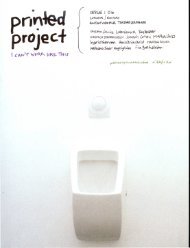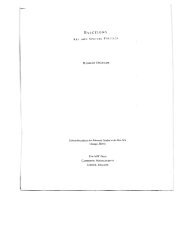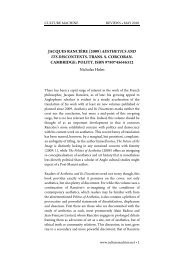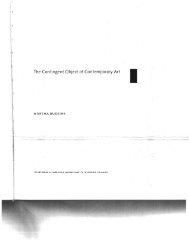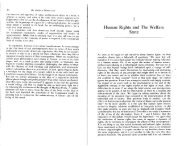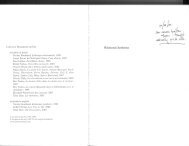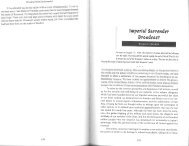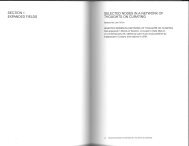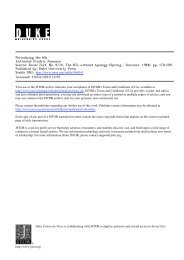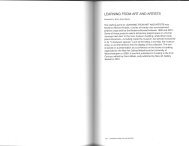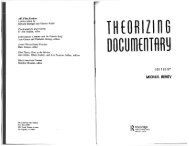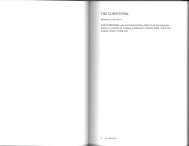Claire Bishop, "The Social Turn: collaboration and ... - doublesession
Claire Bishop, "The Social Turn: collaboration and ... - doublesession
Claire Bishop, "The Social Turn: collaboration and ... - doublesession
Create successful ePaper yourself
Turn your PDF publications into a flip-book with our unique Google optimized e-Paper software.
RIGHT ABOUT NOW<br />
Art & lheory since the 1990S<br />
THE BODY<br />
INTERAmVITY<br />
ENGAGEMENT<br />
DOCUMENTARY STRATEGIES<br />
MONEY<br />
CURATING<br />
Editors<br />
Margriet Schavemaker<br />
Mischa Rakier<br />
Contributors<br />
Jennifer Allen<br />
Sophie Berrebi<br />
<strong>Claire</strong> <strong>Bishop</strong><br />
Beatrice von Bismarck<br />
Maaike Bleeker<br />
Jeroen Boomgaard<br />
Nicolas Bourriaud<br />
Deborah Cherry<br />
Hal Foster<br />
Vit Havranek<br />
Mischa Rakier<br />
Margriet Schavemaker<br />
Marc Spiegler<br />
Olav Velthuis<br />
Kitty Zijlmans<br />
Valiz, Amsterdam
CLAIRE<br />
BISHOP<br />
THE SOCIAL<br />
TURN<br />
COl1ABORATION<br />
AND ITS DISCOr'JEI\rS<br />
"All artists are alike. <strong>The</strong>y dream ofdoin9 somethin9 that's more social, more<br />
collaborative, <strong>and</strong> more real than art." - Dan Graham<br />
Superflex's internet TV station for elderly residents a Liverpool<br />
housing project (Tenantspin, 1999); Annika Eriksson inviting groups<br />
<strong>and</strong> individuals to communicate their ideas <strong>and</strong> skills at the Frieze<br />
An Fair (Do You Want an Audience? , 2004); Jeremy Deller's <strong>Social</strong> Parade<br />
for over twenty social organizations in San Sebastian (2004); Atelier<br />
van Lieshout's A-Portable floating abonion clinic (2001); Jeanne van<br />
Heeswijk's project to tum a condemned shopping mall into a cultural<br />
center for the residents ofVlaardingen, Rotterdam (De Strip ,<br />
2001-2004); Lucy ana's workshops in Johannesburg (<strong>and</strong> elsewhere)<br />
to teach unemployed people new fashion skills <strong>and</strong> discuss collective<br />
solidarity (Nexus Architecture , 1997-present); Temporary Services'<br />
improvised neighborhood environment in an empty lot in Echo<br />
Park, Los Angeles (Construction Site, 2005); Pawel Althamer sending a<br />
group of"difficult" teenagers from Warsaw's working-class Br6dno<br />
district (including his two sons) to hang out at his retrospective in<br />
Maastricht (Bad Kids, 2004).<br />
<strong>The</strong> above-mentioned projects are just a sample of the recent surge<br />
of artistic interest in collectivity, <strong>collaboration</strong>, <strong>and</strong> direct engagement<br />
with specific social constituencies. Although for the most<br />
pan these practices have had a relatively weak profile in the commercial<br />
an world - collective projects are more difficult to market<br />
than works by individual artists <strong>and</strong> they are also less likely to be<br />
RIGHT ABOUT NOW I INTERACTIVITY I <strong>Claire</strong> <strong>Bishop</strong> I <strong>The</strong> <strong>Social</strong> <strong>Turn</strong>
"works" than social events, pUblications, workshops or performances<br />
- they nevertheless occupy an increasingly conspicuous presence<br />
in the public sector. <strong>The</strong> unprecedented expansion of the biennial<br />
is one factor that has certainly contributed toward this shift,<br />
as is the new model ofcommissioning agencies dedicated to the<br />
production of experimental engaged art in the public realm. 1 In One<br />
place AfterAnother: Site-Speci{lc Art <strong>and</strong> Locational Identity (2002), Miwon<br />
Kwon argues that community-specific work takes critiques of<br />
"heavy metal" public art as its point of departure to address the site<br />
as a social rather than fomal or phenomenological framework. <strong>The</strong><br />
intersubjective space created through these projects becomes the<br />
focus - <strong>and</strong> medium - of artistic investigation.<br />
This exp<strong>and</strong>ed field of relational practices currently goes under a variety<br />
of names: socially engaged art, community-based art, experimental<br />
communities, dialogic art, littoral art, participatory, interventionist,<br />
research-based, or collaborative art. <strong>The</strong>se practices are<br />
less interested in a relational aesthetic than in the creative rewards<br />
ofcollaborative activity - whether in the form of working with preexisting<br />
communities or establishing one's own interdisciplinary<br />
network. Many artists now make no distinction between their work<br />
inside <strong>and</strong> outside the gallery, <strong>and</strong> even highly established <strong>and</strong><br />
commercially successful figures like Francis Alys, Pierre Huyghe,<br />
Matthew Barney <strong>and</strong> Thomas Hirschhorn have all turned to social<br />
<strong>collaboration</strong> as an extension of their conceptual or sculptural practice.<br />
Although the objectives <strong>and</strong> output of these various artists <strong>and</strong><br />
groups vary enormously, all are linked by a belief in the empowering<br />
creativity of collective action <strong>and</strong> shared ideas.<br />
This mixed panorama of socially collaborative work arguably forms<br />
what avant-garde we have today: artists using social situations to<br />
produce dematerialized, anti-market, politically engaged projects<br />
that carryon the Modernist call to blur art <strong>and</strong> life. For Nicolas<br />
Bourriaud in his book Relational Aesthetics (1998), the defining text of<br />
relational practice, "art is the place that produces a specific sociability,<br />
" precisely because "it tightens the space ofrelations, unlike TV." For<br />
Grant Kester, in another key text, Conversation Pieces: Community <strong>and</strong><br />
Communication in Modern Art (2004), art is uniquely placed to COunrer a<br />
world in which "we are reduced to an atomized pseudo-community<br />
of consumers, our sensibilities dulled by spectacle <strong>and</strong> repetition."<br />
For these <strong>and</strong> other supporters of socially engaged art, the creative<br />
energy of participatory practices re-humanize - or at least de-alienate<br />
- a society rendered numb <strong>and</strong> fragmented by the repressive<br />
instrumentality of capitalism. But the urgency of this political task<br />
RIGHT ABOUT NOW I INTERACTIVITY I <strong>Claire</strong> <strong>Bishop</strong> I <strong>The</strong> <strong>Social</strong> <strong>Turn</strong><br />
L 11tis critical task is<br />
ponicularly pressing<br />
. jnBritain. where New<br />
use a rbetoric<br />
,]most identical to that<br />
of socially engaged an<br />
1. /lnangel in London. SI(QR to steer culture toward<br />
in the Netherl<strong>and</strong>s <strong>and</strong> ",lic:ies of social indusion.<br />
Nouveau Comm<strong>and</strong>lu.i.reJ' R.edudng an to statistical .<br />
in France are just a few information about wget<br />
thelt come to mind. audience <strong>and</strong> "performaoce<br />
indicators... the government<br />
prioritizes social effect over<br />
Ulnsiderations of artistic<br />
qu>lity.<br />
J. see: www.o
such as a children's workshop with the Turkish painter Komet, a<br />
community picnic with the sculptor Erik Gongrich, <strong>and</strong> a parade<br />
for children organized by the Tem Yapin theater group. Oda Projesi<br />
argue that they wish to open up a context for the possibility of exchange<br />
<strong>and</strong> dialogue, motivated by a desire to integrate with their<br />
surroundings. <strong>The</strong>y insist that they are not setting out to improve<br />
or heal a situation - one of their project leaflets contains the slogan<br />
"exchange not change" - though they clearly see their work as gently<br />
oppositional. By working directly with their neighbors to organize<br />
workshops <strong>and</strong> events, they evidently want to produce a more<br />
creative <strong>and</strong> participatory social fabric. <strong>The</strong> group talks of creating<br />
"blank spaces" <strong>and</strong> "holes" in the face of an over-organized <strong>and</strong> bureaucratic<br />
society, <strong>and</strong> of being "mediators" between groups of people<br />
who normally do not have contact with each other.<br />
Because much of oda Projesi's work exists on the level of art education<br />
<strong>and</strong> community events, we can see the three artists as dynamic<br />
members of the community, bringing art to a wider audience. It is<br />
important that they are opening up the space for non-object-based<br />
practice in Turkey, a country whose art academies <strong>and</strong> art market<br />
are still largely oriented toward painting <strong>and</strong> sculpture. And one<br />
may also be pleased, as I am, that it is three women who have undertaken<br />
this task. But their conceptual gesture of reducing the authorial<br />
status to a minimum ultimately becomes inseparable from<br />
the community arts tradition. Even when transposed to Sweden,<br />
Germany <strong>and</strong> the other countries where Oda Projesi has exhibited,<br />
there is little to distinguish their projects from other socially<br />
engaged practices that revolve around the predictable formulae of<br />
workshops, discussions, meals, film screenings <strong>and</strong> walks. Perhaps<br />
this is because the question of aesthetic value is not valid for Oda<br />
Projesi. When I interviewed the group <strong>and</strong> asked what criteria they<br />
based their own work on, they replied that they judge it by the decisions<br />
they make about where <strong>and</strong> with whom they collaborate:<br />
dynamic <strong>and</strong> sustained relationships provide their markers of suc-<br />
cess, not aesthetic considerations. 4<br />
Indeed, because their practice is<br />
based on <strong>collaboration</strong>, Oda Projesi consider "the aesthetic" to be "a<br />
dangerous word" that should not be brought into discussion. To me<br />
this seemed to be a curious response: ifthe aesthetic is dangerous,<br />
is that not all the more reason it should be interrogated?<br />
Oda Projesi's ethical approach was adopted by the Swedish curator<br />
Maria Lind in a recent essay on its work. Lind is one of the most<br />
articulate supporters of political <strong>and</strong> relational practices, <strong>and</strong> she<br />
undertakes her curatorial work with a trenchant commitment to<br />
RIGHT ABOUT NOW 1 INT£RACTIVITY 1 <strong>Claire</strong> <strong>Bishop</strong> I" <strong>The</strong> <strong>Social</strong> <strong>Turn</strong><br />
4. <strong>Claire</strong> <strong>Bishop</strong>, ·What<br />
We Made Together,"<br />
interView with Cda Pmjesi,<br />
Untitled, Spring 2005.<br />
62<br />
s. Maria Lind in: Cl.Ure<br />
OOhert)' (ed.). Contemporary<br />
,\/I: FromStwlio tDSituation<br />
(LOndon: Black Dog<br />
pUblishing , 2004).<br />
6. For example, Lucy<br />
Lippard, concluding her<br />
boOk 1litwre o(the Local<br />
(199]), presents an eight·<br />
point "ethic of place" for<br />
.nists who work with<br />
communities. Crant Kester's<br />
c",,,,,,,rion Pi",,, (2004),<br />
while lucidly articulating<br />
many of the problems<br />
associated with such<br />
practices. nevertheless<br />
advocates an 4It. of concrete<br />
) interventions in which the<br />
mist does not occupy a.<br />
position of pedagogical or<br />
creativem;!.lltery.lnCood<br />
Jnlentions: judying th'Arto(<br />
I Encowuer (Amsterdam: Fonds<br />
BKVB, 2005), the Dutch<br />
critic Erik H.goort axgues<br />
that we must not shy from<br />
making moral judgments<br />
an this.ut.: ·we must<br />
weigb up the presentation<br />
<strong>and</strong> representation of an<br />
.mist'S good intentions,"<br />
63<br />
the social. In her essay on Oda Projesi, she notes that the group is<br />
not interested in showing or exhibiting art but in"using art as a<br />
means for creating <strong>and</strong> recreating new relations between people ."5<br />
She discusses the collective's project in Riem, near Munich, in<br />
which the group collaborated with a local Turkish community to<br />
organize a tea party, guided tours led by the residents, hairdressing<br />
<strong>and</strong> Tuppetware parties, <strong>and</strong> the installation of a long roll of<br />
paper that people wrote <strong>and</strong> drew on to stimulate conversations.<br />
Lind compares this endeavor to Thomas Hirschhorn's Bataille Monument,<br />
his well-known <strong>collaboration</strong> with a mainly Turkish community<br />
in Kassel for Documenta 11 (2002). Lind observes that Oda Projesi,<br />
contrary to Thomas Hirschhorn, are the better artists because of the<br />
equal status they give to their collaborators: "[Hirschhorn's] aim<br />
is to create art. For the Bataille Monument he had already prepared,<br />
<strong>and</strong> in part also executed, a plan on which he needed help to implement.<br />
His participants were paid for their work <strong>and</strong> their role was<br />
that of the 'executor' <strong>and</strong> not'co-creator.''' Lind goes on to argue<br />
that Hirschhorn's work, by using participants to critique the art<br />
genre of the monument, was rightly criticized for "exhibiting" <strong>and</strong><br />
making exotic marginalized groups <strong>and</strong> thereby contributing to a<br />
form of a social pornography." By contrast, she writes, Oda Projesi<br />
"work with groups of people in their immediate environments <strong>and</strong><br />
allow them to wield great influence on the project."<br />
It is worth looking closely at Lind's criteria here. Her judgment is<br />
based on an ethics of authorial renunciation: the work of Oda Projesi<br />
is better than that of Thomas Hirschhorn because it exemplifies a<br />
superior model of collaborative practice. <strong>The</strong> conceptual density <strong>and</strong><br />
artistic significance of the respective projects are sidelined in favor<br />
of a judgment on the artists' relationship with their collaborators.<br />
Hirschhorn's (purportedly) exploitative relationship is compared<br />
negatively to Oda projesi's inclusive generosity. In other words,<br />
Lind downplays what might be interesting i'n Oda Projesi's work as<br />
art _ the possible achievement of making dialogue a medium, or the<br />
significance of dematerializing a project into social process. Instead<br />
her criticism is dominated by ethical judgments on working proce-<br />
dure <strong>and</strong> intentionality.<br />
Similar examples can be found in the writing on Superflex, Ona,<br />
Eriksson <strong>and</strong> many other artists working in a socially ameliorative<br />
tradition. It finds support in most of the theoretical writing on art<br />
that collaborates with "real" people (that is to say, those who are<br />
not the artist's friends or other artists)." In these examples, autho-<br />
RIGHT ABOUT NOH 1 INTERACTIVITY 1 <strong>Claire</strong> <strong>Bishop</strong> 1 <strong>The</strong> <strong>Social</strong> <strong>Turn</strong>
ial intentionality (or a humble lack thereof) is privileged over a<br />
discussion of the work's conceptual significance as a social <strong>and</strong> aesthetic<br />
form. Paradoxically, this leads to a situation in which not<br />
only collectives but also individual artists are praised for their authorial<br />
renunciation. And this may explain, to some degree, why<br />
socially engaged art has been largely exempt from art criticism:<br />
emphasis is shifted away from the disruptive specificity of a given<br />
work <strong>and</strong> onto a generalized set of moral precepts.<br />
In his book Conversation Pieces (2004), Grant Kester argues that consultative<br />
<strong>and</strong> "dialogic art" art necessitates a shift in our underst<strong>and</strong>ing<br />
of what art is - away from the visual <strong>and</strong> sensory (which<br />
are individual experiences) <strong>and</strong> toward "discursive exchange <strong>and</strong><br />
negotiation." He challenges us to treat communication as an aesthetic<br />
form but ultimately he fails to defend this <strong>and</strong> seems perfectly<br />
content to allow that a socially collaborative art project could<br />
be deemed a success if it works on the level of social intervention<br />
even though it founders on the level of art. In the absence of a<br />
commitment to the aesthetic, Kester's position adds up to a familiar<br />
summary of the intellectual trends inaugurated by identity<br />
politics: respect for the other, recognition of difference, protection<br />
of fundamental liberties <strong>and</strong> an inflexible mode of political<br />
correctness. As such, it also constitutes a rejection of any art that<br />
might offend or trouble its audience - most notably the historical<br />
avant-garde, within whose lineage Kester nevertheless wishes to<br />
situate social-engagement as a radical practice. He criticizes Dada<br />
<strong>and</strong> surrealism, which sought to "shock" viewers into being more<br />
sensitive <strong>and</strong> receptive to the world, .because they assume that the<br />
artist is a privileged bearer of insights. I would argue that such discomfort<br />
<strong>and</strong> frustration - along with absurdity, eccentricity, doubt<br />
or sheer pleasure - can, on the contrary, be crucial elements of a<br />
work's aesthetic impact <strong>and</strong> are essential to gaining new perspectives<br />
on our condition. <strong>The</strong> best examples of socially collaborative<br />
art give rise to these - <strong>and</strong> many other - effects, which must be read<br />
alongside more legible intentions, such as the recovery of a fantasmatic<br />
social bond or the sacrifice of authorship in the name of a<br />
"true" <strong>and</strong> respectful <strong>collaboration</strong>. Some of these projects are well<br />
known: Thomas Hirschhorn's Musee Precaire (2004) <strong>and</strong> 24h Foucault<br />
(2004), Aleks<strong>and</strong>ra Mir's Cinema for the Unemployed (199B), Francis Alys'<br />
When Faith Moves Mountains (2003). Rather than positioning themselves<br />
within an activist lineage in which art is marshaled to social<br />
change, these artists have a closer relationship to avant-garde theater,<br />
performance or even architectural theory. As a consequence,<br />
perhaps, they attempt to think the aesthetic <strong>and</strong> the social/political<br />
together, rather than subsuming both within the ethical.<br />
<strong>The</strong> British artist phil Collins fully integrates these two concerns<br />
in his work. Invited to undertake a residency in Jerusalem, he decided<br />
to hold a disco-dancing marathon for teenagers in Ramallah,<br />
which he recorded to produce the two-channel video <strong>The</strong>y shoot Horses<br />
(2004). Collins paid nine teenagers to dance continually for eight<br />
hours, on two consecutive days, in front of a garish 'Pink wall to<br />
an unrelentingly cheesy compilation of pop hits. <strong>The</strong> teenagers are<br />
mesmerizing <strong>and</strong> irresistible as they move from exuberant partying<br />
to exhaustion. <strong>The</strong> sound track's banal pop lyrics of ecstatic love<br />
<strong>and</strong> rejection acquire poignant connotations in the light of the kids'<br />
double endurance of the marathon <strong>and</strong> of the interminable political<br />
crisis in which they are trapped. It goes without saying that <strong>The</strong>y<br />
shoot Horses is a perverse representation of the "site" that the artist<br />
was invited to respond to: the Occupied Territories are never shown<br />
explicitly, but are ever-present as a frame. This use of the hors-cadre<br />
has a political purpose: Collins' decision to present the participants<br />
as generic globalized teenagers becomes clear when we consider the<br />
puzzled questions regularly overheard when watching the video in<br />
public: How come Palestinians know Beyonce? HOVY come they are<br />
wearing Nikes? By voiding the work of direct political narrative,<br />
Collins demonstrates how swiftly this space is filled by fantasies<br />
generated by the media's selective production <strong>and</strong> dissemination<br />
of images from the Middle East. By using pop music as familiar to<br />
Palestinian as to Western teens, Collins also provides a commeqtary<br />
on globalization that is considerably more nuanced than most activist-oriented<br />
political art. <strong>The</strong>y shoot Horses plays off the conventions<br />
of benevolent socially collaborative practice (it creates a new narrative<br />
for its participants <strong>and</strong> reinforces a social bond) but combines<br />
this with the visual <strong>and</strong> conceptual conventions of reality TV. <strong>The</strong><br />
presentation of the work as a two-screen installation lasting a full<br />
eight-hour working day subverts both genres in its emphatic use of<br />
seduction on the one h<strong>and</strong> <strong>and</strong> grueling duration on the other.<br />
<strong>The</strong> work of Polish artistArtur Zmijewski, like that of Collins, often<br />
revolves around the devising <strong>and</strong> recording of difficult, <strong>and</strong><br />
sometimes even excruciating, situations. In Zmijewski's video <strong>The</strong><br />
Singing Lesson I (2001), a group of deaf students are filmed singing<br />
Maklakiewicz's 1944 Polish Mass in a Warsaw church. <strong>The</strong> opening<br />
shot is staggeringly hard: an image of the church interior, all elegant<br />
neoclassical symmetry, is offset by the cacophonous distorted<br />
voice of a young girl. She is surrounded by fellow students who,<br />
RIGHT ABOUT NOW I INTERACTIVITY I <strong>Claire</strong> <strong>Bishop</strong> I <strong>The</strong> <strong>Social</strong> TUrn 65 RIGHT ABOUT NOW I INTERACTIVITY I <strong>Claire</strong> <strong>Bishop</strong> I <strong>The</strong> <strong>Social</strong> <strong>Turn</strong>
unable to hear her effons, chat with one another in sign language.<br />
Zmijewski's editing draws constant attention to the contrast between<br />
the choir <strong>and</strong> their environment, suggesting that religious<br />
paradigms of perfection continue to inform our ideas of beauty.<br />
A second version of <strong>The</strong> Sin9in9 Lesson was filmed in Leipzig in 2002.<br />
This time the deaf students, together with a professional chorister,<br />
sing a Bach cantata to the accompaniment ofa baroque chamber orchestra,<br />
in a church where Bach once served as cantor. <strong>The</strong> German<br />
version is edited to reveal a more playful side of the experiment.<br />
Some students take the task of performing seriously; others ab<strong>and</strong>on<br />
it in laughter. <strong>The</strong>ir gestures of sign language in rehearsal are<br />
echoed by those of the conductor: two visual languages that serve<br />
to equate the two types of music produced by Zmijewski's experiment<br />
- the harmonies of the orchestra <strong>and</strong> the strained wailing of<br />
the choir. <strong>The</strong> anist's stylized editing, compounded by my inability<br />
to underst<strong>and</strong> sign language, seem integral to the film's point: we<br />
can only ever have limited access to others' emotional <strong>and</strong> social experiences,<br />
<strong>and</strong> the opacity of this knowledge obstructs any analysis<br />
founded on such assumptions. Instead we are invited to read what<br />
is presented to us - a perverse assemblage of conductor, musicians<br />
<strong>and</strong> deaf choir that produces something more complex, troubling<br />
<strong>and</strong> multi-layered than the release of individual creativity.<br />
It will be protested that both Collins <strong>and</strong> Zmijewski produce videos<br />
for consumption within a gallery, as if the space outside it were<br />
automatically more authentic - a logic that has been definitively<br />
unraveled by Kwon in One Place AfterAnother. Her advocacy of an that<br />
"unworks" community might usefully be applied to the practice of<br />
British artist Jeremy Deller. In 2001 he organized the re-enactment<br />
of a key event from the English miners' strike of1984 - a violent<br />
clash between miners <strong>and</strong> the police in the village of Orgreave in<br />
Yorkshire. <strong>The</strong> Battle ofOr9reave was a one-day re-enactment of this<br />
. clash, performed by former miners <strong>and</strong> policemen together with<br />
a number of historical re-enactment societies. Although the work<br />
seemed to contain a twisted therapeutic element (in that both miners<br />
<strong>and</strong> police involved in the struggle were involved, some of them<br />
swapping roles), <strong>The</strong> BattleofOr9reave did not seem to heal a wound so<br />
much as to reopen it. Deller's event was both politically legible <strong>and</strong><br />
utterly pointless: it summoned the experiential potency of a political<br />
demonstration, but only to expose a wrong seventeen years too<br />
late. It gathered the people together to remember <strong>and</strong> replay a disastrous<br />
event, but this remembrance took place in circumstances<br />
more akin to a village fair, with a brass b<strong>and</strong>, food stalls <strong>and</strong><br />
RIGHT ABOUT HOW I INTERACTIVITY I <strong>Claire</strong> <strong>Bishop</strong> I <strong>The</strong> <strong>Social</strong> <strong>Turn</strong> 66<br />
children running around. This contrast is particularly evident in<br />
the only video documentation of <strong>The</strong> Battle ofOr9reave, which forms<br />
part of a feature-length film by Mike Figgis, a left-wing filmmaker<br />
who explicitly uses the work as a vehicle for his indictment of the<br />
Thatcher government. Clips of Deller's event are shown between<br />
emotional interviews with former miners, <strong>and</strong> the clash of tone is<br />
disconcerting. <strong>The</strong> involvement of historical re-enactment societies<br />
is integral to this ambiguity, since their participation symbolically<br />
elevated the relatively recent events at Orgreave to the status<br />
of English history, while drawing attention to this eccentric leisure<br />
activity in which bloody battles are enthusiastically replicated as<br />
a social <strong>and</strong> aesthetic diversion. <strong>The</strong> whole event could be understood<br />
as contemporary history painting that collapses representation<br />
<strong>and</strong> reality.<br />
Deller, Collins <strong>and</strong> Zmijewski do not make the "correct" ethical<br />
choice, they do not embrace the Christian ideal of self-sacrifice;<br />
instead, they act on their desire without the incapacitating restrictions<br />
of guilt. In so doing, their work joins a tradition of highly<br />
authored situations that fuse social reality with carefully calculated<br />
artifice. This tradition still needs to be written, beginning,<br />
perhaps, with the "Dada-Season" in the spring of 1921 - a series of<br />
manifestations that sought to involve the Parisian public. <strong>The</strong> most<br />
salient of these events was an "excursion" to the church of Saint<br />
Julien Ie Pauvre, which drew more than one hundred people despite<br />
the pouring rain. <strong>The</strong> inclement weather cut the tour shon <strong>and</strong><br />
prevented an "auction of abstractions" from being realized. In this<br />
Dada excursion, as in the examples given above, inter-subjective<br />
relations were not an end in themselves, but rather served to unfold<br />
a more complex knot of concerns about pleasure, visibility, engagement<br />
<strong>and</strong> the conventions of social interaction.<br />
<strong>The</strong> discursive criteria ofsocially engaged an are, at present, drawn<br />
from a tacit analogy between anti-capitalism <strong>and</strong> the Christian<br />
"good soul." In this schema, self-sacrifice is triumphant: the anist<br />
should renounce authorial presence in favor of allowing participants<br />
to speak through him or her. This self-sacrifice is accompanied<br />
by the idea that an should extract itself from the "useless"<br />
domain of the aesthetic <strong>and</strong> be fused with social praxis. As the<br />
French philosopher Jacques Ranciere has observed, this denigration<br />
of the aesthetic ignores the fact that the system of an as we underst<strong>and</strong><br />
it in the West - the "aesthetic regime of an" inaugurated by<br />
Schiller <strong>and</strong> the Romantics <strong>and</strong> still operative to this day - is predicated<br />
precisely on a confusion between an's autonomy (its position<br />
67 RIGHT ABOUT NOW I IHTERACTIVITY I <strong>Claire</strong> <strong>Bishop</strong> I <strong>The</strong> <strong>Social</strong> <strong>Turn</strong>
at one remove from instrumental rationality) <strong>and</strong> heteronomy (its<br />
blurring of art <strong>and</strong> life).'Untangling this knot - or ignoring it by<br />
seeking more concrete ends for art - is slightly to miss the point,<br />
since the aesthetic is, according to Ranciere, the ability to think<br />
contradiction: the productive contradiction of art's relationship<br />
to social change, characterized precisely by that tension between<br />
faith in art's autonomy <strong>and</strong> belief in art as inextricably bound to<br />
the promise of a better world to come. For Ranciere, the aesthetic<br />
does not need to be sacrificed at the altar of social change, as it already<br />
inherently contains this ameliorative promise. <strong>The</strong> best art<br />
manages to fulfill the promise of the antinomy which Schiller saw<br />
as the very root of aesthetic experience <strong>and</strong> not surrender itself to<br />
exemplary (but relatively ineffectual) gestures. <strong>The</strong> best collaborative<br />
practices of the last ten years address this contradictory pull<br />
between autonomy <strong>and</strong> social intervention <strong>and</strong> reflect on this antinomy,<br />
both in the structure of the work <strong>and</strong> in the conditions of<br />
its reception. It is to this art - however uncomfortable, exploitative,<br />
or confusing it may first appear - that we must tum for an alternative<br />
to the well-intentioned homilies that today pass for critical discourse<br />
on social <strong>collaboration</strong>.<br />
7. Jacques '"!he<br />
Aesthetic Revolution <strong>and</strong><br />
Its Outcomes," in: Nav<br />
uft REIri



